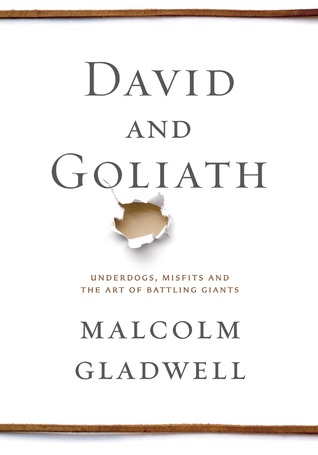 I've read one Malcolm Gladwell book before, What the Dog Saw, which was a collection of articles Gladwell had written over the years that basically examine how people think about different things. Each article used a couple of different case studies that played into the same theme. David and Goliath, which was the book for the Deliberate Reader Book Club for November, is basically an expanded version of that. This book is about how apparent underdogs actually usually have unapparent strengths, and how the "giants" the underdogs face off against typically have weaknesses that can be used against them. He starts with examining the actual "David and Goliath" story and putting forth a few historical facts and modern theories that make clear that the story isn't what it initially seems to be--and then he expands upon that theme throughout the rest of the book. It's divided into three sections, which each examines a different aspect of his argument. Each chapter builds up to the "argument" for that part, and uses several different examples twisted together to do so.
I've read one Malcolm Gladwell book before, What the Dog Saw, which was a collection of articles Gladwell had written over the years that basically examine how people think about different things. Each article used a couple of different case studies that played into the same theme. David and Goliath, which was the book for the Deliberate Reader Book Club for November, is basically an expanded version of that. This book is about how apparent underdogs actually usually have unapparent strengths, and how the "giants" the underdogs face off against typically have weaknesses that can be used against them. He starts with examining the actual "David and Goliath" story and putting forth a few historical facts and modern theories that make clear that the story isn't what it initially seems to be--and then he expands upon that theme throughout the rest of the book. It's divided into three sections, which each examines a different aspect of his argument. Each chapter builds up to the "argument" for that part, and uses several different examples twisted together to do so.This is a very readable book, but I think its third part was its weakness. The first two parts are more obviously about "the art of battling giants" than the third, which is more about how apparent power isn't always everything. Though that argument makes sense in the whole structure of the book, I found myself unconvinced about how Gladwell went about it. In the "David and Goliath" story, Goliath's weaknesses--enumerated by Gladwell in the foreword--contributed to his downfall. In the book, however, it seemed like Gladwell's examples were more just about how the "giants" weren't as tough as they thought, not how the "Davids" of the equation actually went about defeating them. I think, in a way, this might have been because the argument went on for a bit too long. The point Gladwell was trying to make here was made perfectly well in the earlier parts of the book, though not as explicitly. When he tried to make it more explicit using more examples that he hadn't brought in before, I think it got a bit lost in the muddle.
The examples themselves are this book's real strength, though. Especially the people the examples feature. Each chapter has two or three "main characters," real people who were involved in the events that Gladwell relates. While some of the background info, which tends to include technical explanations and some data sets and figures, can get a bit dry, the people in the examples really bring the story home and make their experiences shine, and therefore make the point that much clearer. Gladwell does an excellent job of interweaving the stories and the background to make what could be some very dry and academic info into something that's a pleasure to read, with examples that stick in the mind and stick the point there with them. It's nonfiction, but it's not heavy, and that was a very good reason for Sheila to pick it as the book club selection for the month. I'm looking forward to discussing it, and I would definitely be open to reading another Gladwell book in the future, though I don't think they're something I would seek out unless the topic was one that specifically interested me.
3.5 stars out of 5.
No comments:
Post a Comment